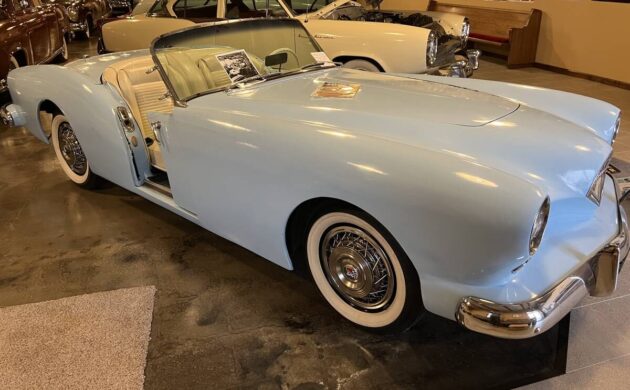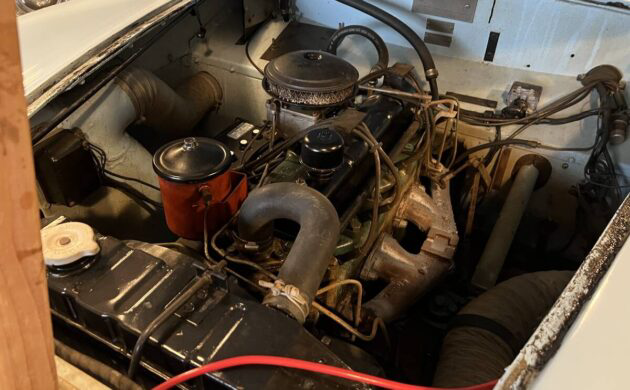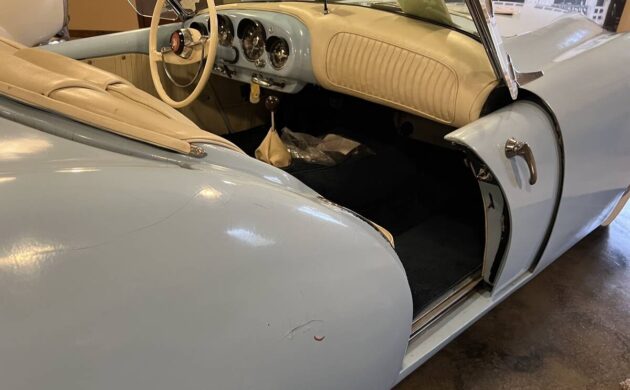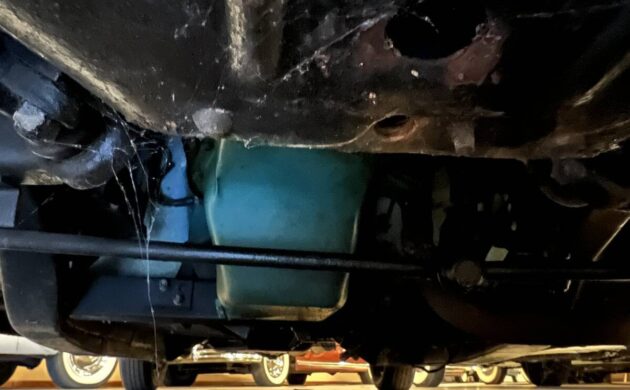In 1945, Henry J. Kaiser and Joseph Frazer started an automaker, Kaiser-Frazer, from the seeds of financially stretched Graham-Paige Motors. Their first cars sold well to an eager public who was willing to buy almost anything. But Kaiser was using his shipbuilding skills to procure materials in a war-starved economy at an enormous cost. While that ensured Kaiser-Frazer could keep its assembly lines humming, it did nothing for the bottom line. Later, to save a few pennies, Frazer recommended cutting production – a plan that Kaiser overruled. The consequence was even more red ink. Frazer left the company, prompting a name change to Kaiser Motors. Meanwhile, another irascible person in the form of “Dutch” Darrin was bouncing around style departments, working for Packard, then as a consultant for Kaiser. Urging Kaiser toward offering a sports car was proving futile, so Darrin designed the car himself and presented it to Henry Kaiser, who gave an emphatic “no”. While Kaiser was a scion of business, he was no match for his young wife, who declared the new sporting car to be the most beautiful thing she had ever seen. Thus, the Kaiser Darrin received the stamp of approval, and the first car rolled off the line for the 1954 model year. Here on craigslist is a 1954 Kaiser Darrin, with an asking price of $75,000 OBO, located in Stillwater, Oklahoma. The car belonged to the seller’s late father. The seller says the car has special order exterior/interior colors; the tag lists “999” and “888” as paint and trim codes which are likely defaults to indicate custom choices. Thanks to T.J. for this stylish tip!
The Kaiser Darrin was actually introduced in 1952 at the Los Angeles Motorama, based on the Henry J chassis with a fiberglass body. After attempts to procure or produce a V8 came to naught and managed to delay production by a year – by which time Kaiser had merged with Willys – the motor chosen for the car became the 161 cu in. Hurricane in-line six-cylinder, generating only 90 bhp, a dramatically poor choice. The Corvette was already having trouble selling copies with its six-cylinder rated at 150 bhp. The Kaiser Darrin did manage to go zero to sixty in fifteen seconds, but that wasn’t enough to spur sales.
Furthermore, design features such as the slide-in doors and a very awkward convertible top arrangement only annoyed customers more. The door tracks picked up dirt and frequently refused to close; and the top, buried in the trunk, required an engineering degree and the dexterity of a monkey to operate. The transmission is a three-speed manual with an overdrive. The seller indicates that his car has not been driven in a couple of years.
The undercarriage photos are a bit dark but as far as I can tell, the greasy side looks straight and not too road-weary. Only 435 of these cars were made in that single production year of 1954. Like the original six-cylinder Corvette, time has been kind to collectors’ assessment of the Kaiser Darrin, resulting in going prices for nice examples north of $90,000 these days. This car has some paint imperfections, and the drivetrain is an unknown: what’s a reasonable offer on this one?









Always it seems, the dying company has a Hail-Mary play. Studebaker had its Avanti, a credible effort. Pontiac, two generations later, had the Solistice.
Yugo had its convertible with an automatic transmission. And here, the dying embers of Kaiser-Frazer, are highlighted in this plastic-fantastic on a (rejected by buyers) Henry J chassis.
It wasn’t going to work; but hope springs eternal. Designing something like this on the cheap, was probably a morale booster for the designers and assemblers. But, as you can see…absent the mechanical parts…it was a flop.
If you’re gonna wear a holster…you better first have your gun ready.
It may not have been so off-the mark as it seems today…we tend to forget, as mentioned, the first Corvettes only came with heavy sixes. And kingpin front suspension. But somehow I cannot believe, for the small run the Darrin had, they couldn’t have sourced a potent motor – a Ford Taunus V4 (used by Saab also) or even a Buick V8 (something Henry and son Edgar later did with the Wagoneer). THAT would have drawn away from Corvette and Thunderbird sales…or, maybe given the course that the company had plotted, merger into Willys and downsizing to light-trucks only…they no longer wanted the product they’d been working on for a couple of years.
This was built years before any of those engine were available.
I remember in the early ’70’s seeing one driving through downtown
Kalispell,Montana.You don’t mistake it for any other car on the road.
Buick had a small V8 from IIRC 1953.
The Ford Taunus was the result of the prototype Cardinal, a tiny city car that Ford was preparing to launch in the early 1950s. I just checked dates, I guess it was launched in Europe in 1962…but I thought the development work on the V4 was done much earlier.
So…that one, I was wrong on.
I sometimes wonder what the founders of some of these car companies would say if they could see the rich prices their formerly shunned products sell for these days.
All those dying companies made a common mistake. They built a niche car in order to try to survive. The last thing they needed to survive was to build a car that could only be sold to a small number of people. A family, or the “average Joe” for that matter, could never use an Avanti, a Darin or a Solstice.
They could have sourced the Continental Red Seal engine (226 cubes) that they used on their other models. Why they didn’t, who knows.
The Darrin is pleasant to drive with good handling. The 226 would have added too much weight over the front end ruining the easy steering and nice handling. Besides the HJ frame was engineered for the Willys engine.
As for the niche cars, they were probably looking for something flashy. The old auto rule was that on the showroom floor you always had a convertible with the top down. Most wouldn’t buy it, but it made everything else on the floor look more desirable.
And on a similar note, Plymouth had the Prowler
Is it wrong that if I had unlimited funds, I’d restomod this on a modern chassis with a more potent engine? Always thought they were cool cars.
Yes
Absolutely wrong! With only 485 produced, and this one is pristine, making it restomod would be a travesty. Find a junker if that’s what you want to do.
Who needs crazy power in a convert? Just go for a nice ride on a warm day and watch the world go by. Performance is a fools option, dangerous and expensive. The six was just fine in my opinion. I get great pleasure from my tiny four cylinder in my Miata, same thing.
Yes but you have modern engineering that can make the most of those four cylinders and MUCH better handling in the Miata. Heck, Miatas have entire race series devoted to them. Very capable cars.
I love driving it. If I want fast I’ll buy a Honda civic.
The Savoy Auto Museum in Cartersville, GA had one on display a few weeks ago. They do change their displays (understand ‘fins’ are recently on display) so it may not be there any longer. Nice museum.
Cool, Eric; I live in Johns Creek, GA, a northern suburb of Atlanta. I had no idea such a cool museum was so close! Thanks for the info!
I have seen a few of these, super cool but on the small side.
Is it in Stillwater or Dallas?
JustPassinThru, Buick didn’t have a small V8 until 1961. The Special and Skylark had the aluminum 215 engine.
In 1954 the Buick Special came with a 264 cast iron V8, that much is true, but it shared the basic dimensions and bulk of the 322 engine in the Century, Super and Roadmaster.
https://en.wikipedia.org/wiki/Buick_V8_engine
The 264 was made from 1953.
You’re thinking of the aluminum V8. That one didn’t last long…but, once again, cross-pollination. The Buick V6, cast iron, was derived from the aluminum V8. It was almost as light, and almost as powerful. Alas, not nearly as smooth.
But, again, Henry Kaiser to the rescue! After a Jeep dealer found that the Buick V6 dropped right into a CJ engine bay…Kaiser Jeep arranged for a factory option, in time to match with the CJ-based Jeepster in 1966. And when Buick decided the V6 wasn’t the future, Kaiser-Jeep bought, not just the design, but the entire engine line, moved to Toledo.
In the end, that is what saved it, for GM to repurchase in 1974. Given the sorry state of the General’s engineering in those years, I’d shudder to think of what they’d have come up with if the former V6 equipment wasn’t ready to go.
as a little kid, the early 60’s, this was a dream car of mine.
For $75K this one should hum and run smoothly. Seller is looking to unload a problem on someone else. For $75K for a car that hasn’t run in a couple years, let him either keep it or get it to run and drive with no problems.